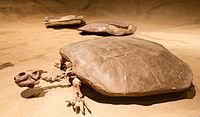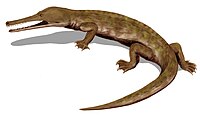North Horn Formation
| North Horn Formation | ||
|---|---|---|
Ma | ||
Approximate paleocoordinates 46°48′N 88°00′W / 46.8°N 88.0°W | | |
| Region | Utah | |
| Country | ||
| Extent | ~140 km (87 mi) | |
| Type section | ||
| Named for | North Horn Mountain | |

The North Horn Formation is a widespread non-marine sedimentary unit with extensive outcrops exposed in central and eastern Utah. The formation locally exceeds 3,600 feet (1,100 m) in thickness and is characterized by
Stratigraphy

The North Horn Formation is a non-marine, stratigraphic unit located in east and central Utah which unconformably overlies the Late Cretaceous
Price Canyon, Utah, the basal contact for the North Horn Formation is Maastrichtian (latest Cretaceous) in age,[1][2][3] whereas its base is Paleocene in age on the eastern side of the swell.[2] Some of the most complete sections of the North Horn Formation are exposed west of the San Rafael Swell at North Horn Mountain in which the local stratigraphy sometimes exceeds 3,600 ft (1,100 m) in thickness. Further to the east, towards Green River, Utah, stratigraphic sections are significantly thinner compared to sections in the west with thicknesses varying between as little as 50 to 130 ft (15 to 40 m).[2][4]
Subdivisions
The formation is divided into three informal units based on broad but distinct
redbed
unit, which is nearly a 390 ft (120 m) thick and is composed of red brown mottled siltstone and sandy siltstone.
Paleontology
Characteristic dinosaur taxa include the ceratopsian
University of Colorado at Denver.[17] Bird and dinosaur eggs have also been found at the site, along with unidentified hadrosaur fossils (possibly from Edmontosaurus or Kritosaurus).[18]
Fossil content
Color key
|
Notes Uncertain or tentative taxa are in small text; |
| Genus | Species | Location | Stratigraphic position | Abundance | Notes | Image |
|---|---|---|---|---|---|---|
| Adocus[19] | A. sp[20] | 
| ||||
| Alamosaurus[21] | A. sanjuanensis[21] | 
| ||||
| Basilemys[22] | B. sp[23] | 
| ||||
| Champsosaurus[24] | C. sp[25] | 
| ||||
| Lepisosteus[26] | L. sp.[27] | 
| ||||
| Polyglyphanodon[28] | P. sternbergi[29] | 
| ||||
| Pteraichnus[17] | Found at an unnamed site.[17] | Specimens kept at the Dinosaur Tracks Museum, of the University of Colorado at Denver.[17] | ||||
| Torosaurus[21] | T. utahensis[21] | 
| ||||
| Tyrannosaurus[30][21] | T. rex [31][21] | 
|
See also
- List of dinosaur-bearing rock formations
- Kaiparowits Formation
References
- ^ a b c d Fouch, T. D., Lawton, T. F., Nichols, D. J., Cashion, W. B., Cobban, W. A. (1983). Patterns and timing of synorogenic sedimentation in Upper Cretaceous rocks of central and northeast Utah. In Reynolds, M. W., and Dolly, E. D., eds., Mesozoic paleogeography of west central United States. Society of Economic Paleontologists and Mineralogists. Pp. 305-336.
- ^ a b c d e f g Lawton, T. F. (1986). Fluvial systems of the Upper Cretaceous Mesaverde Group and Paleocene North Horn Formation, central Utah: A record of transition from thin-skinned to thick-skinned deformation in the foreland region. Paleotectonics and Sedimentatio in the Rocky Mountain Region, United States. AAPG Special Volumes, M 41. Pp. 423-442.
- ^ a b c d Lawton, T. F., Talling, P. J., Hobbs, R. S., Trexler, J. H. Jr, Weiss, M. P., Burbank, D. W. (1993). Structure and stratigraphy of Upper Cretaceous and Paleocene strata (North Horn Formation), eastern San Pitch Mountains, Utah – sedimentation at the front of the Sevier orogenic belt. United States Geological Survey, Bulletin 1787-II, Pp. 1-33.
- ^ a b c d Difley, R., Ekdale, A. A. (2002). Faunal implications of an environmental change before the Cretaceous-Tertiary (K-T) transition in central Utah. Cretaceous Research, 23:315-331.
- ^ Myung-Suk, Y., Cross, A.T. (1997). Palynostratigraphy of Upper Cretaceous-Lower Tertiary strata, Price Canyon, Utah. Review of Palaeobotany and Palynology 97, p.53-66
- ^ a b Gilmore, C.W. (1946). Reptilian fauna of the North Horn Formation of central Utah. United States Geological Survey Professional Paper, 210-C, 53 p
- ^ a b Cifelli, R.L., Czaplewski, N.J., Rose, K.D. (1995). Knowledge of Paleocene Mammals from the North Horn Formation, Central Utah. The Great Basin Naturalist. Vol. 55:4. Pp. 304-314
- ^ a b Cifelli, R.L., Nydam, R.L., Eaton, J.G., Gardner, J.D., Kirkland, J.I. (1999). Vertebrate Faunas of the North Horn Formation (Upper Cretaceous-Lower Paleocene), Emery and Sanpete Counties, Utah. In Gillette, D.D. (ed.) Vertebrate Paleontology in Utah. Utah Geological Survey Miscellaneous Publication 99-1: 377-388
- S2CID 130309439. Retrieved 18 October 2020.
- ^ Spieker, E. M. (1946). Late Mesozoic and early Cenozoic history of central Utah. United States Geological Survey. Professional Paper 205-D, 117-159
- S2CID 131583311. Retrieved 13 April 2012.
- ^ Black, Riley. "Tyrannosaurus vs. Alamosaurus". Smithsonian Magazine. Smithsonian Institution. Retrieved 23 March 2009.
- S2CID 131583311. Retrieved 18 October 2020.
- ^ Sampson, S.D., Loewen, M.A.(2005). Tyrannosaurus from the Upper Cretaceous (Maastrichtian) North Horn Formation of Utah: biogeographic and paleoecologic implications. Journal of Vertebrate Paleontology 25:2, 469-472
- S2CID 128849169.
- S2CID 130086187. Retrieved 19 November 2020.
- ^ ISSN 1612-4138.
- S2CID 128849169.
- ^ Gilmore, Charles W. (1946). "Reptilian fauna of the North Horn Formation of central Utah". US Government Printing Office. 210: 48. Retrieved 24 October 2020.
- ^ Gilmore, Charles W. (1946). "Reptilian fauna of the North Horn Formation of central Utah". US Government Printing Office. 210: 48. Retrieved 24 October 2020.
- ^ ISBN 0-520-24209-2.
- ^ Gilmore, Charles W. (1946). "Reptilian fauna of the North Horn Formation of central Utah". US Government Printing Office. 210: 48. Retrieved 24 October 2020.
- ^ Gilmore, Charles W. (1946). "Reptilian fauna of the North Horn Formation of central Utah". US Government Printing Office. 210: 48. Retrieved 24 October 2020.
- ^ Gilmore, Charles W. (1946). "Reptilian fauna of the North Horn Formation of central Utah". US Government Printing Office. 210: 48. Retrieved 24 October 2020.
- ^ Gilmore, Charles W. (1946). "Reptilian fauna of the North Horn Formation of central Utah". US Government Printing Office. 210: 48. Retrieved 24 October 2020.
- ^ Gilmore, Charles W. (1946). "Reptilian fauna of the North Horn Formation of central Utah". US Government Printing Office. 210: 52. Retrieved 24 October 2020.
- ^ Gilmore, Charles W. (1946). "Reptilian fauna of the North Horn Formation of central Utah". US Government Printing Office. 210: 52. Retrieved 24 October 2020.
- ^ Gilmore, Charles W. (1946). "Reptilian fauna of the North Horn Formation of central Utah". US Government Printing Office. 210: 51. Retrieved 24 October 2020.
- ^ Gilmore, Charles W. (1946). "Reptilian fauna of the North Horn Formation of central Utah". US Government Printing Office. 210: 48. Retrieved 24 October 2020.
- S2CID 131583311. Retrieved 18 October 2020.
- S2CID 131583311. Retrieved 18 October 2020.


